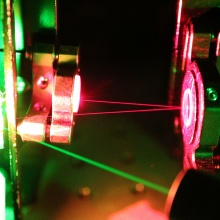Dr. Roman Bek and Norbert Witz-Haszler are alumni of the University of Stuttgart, and have successfully established their own startup called Twenty-One Semiconductors. Now the High-Tech Gründerfonds (HTGF) is investing in the young company. The seven-strong team at Twenty-One Semiconductors manufactures semiconductor-based laser crystals for biomedical applications. These crystals make it possible to produce laser modules in the yellow spectrum, which was previously difficult to achieve, which in turn makes it possible to significantly increase the information content of measurements of cell and tissue samples.
Both founders studied Physics at the University of Stuttgart and wrote their master’s theses at the Institute of Semiconductor Optics and Functional Interfaces (IHFG). They also spent a number of years at the Institute working as research assistants. “When I was coming to the end of my doctoral degree studies at the start of 2018 we saw the opportunity to develop industry-compliant products in the field of semiconductor technology based on previous research carried out at the IHFG”, says Bek.
They decided to set up Twenty-One Semiconductors, and were awarded with an EXIST business startup grant from 2018 to 2019. “We got supervision and support from TTI GmbH back when we used to get the EXIST funding in particular”, says Bek. “We used this time to develop an industry-compliant manufacturing process for MEXL laser crystals.”
Analyzing blood and tissue samples using a laser
The demand for laser modules with central wavelengths in the visible spectrum is continually growing, and has a wide range of applications in biomedicine in particular. Highly-specialized beam sources are used in this field for the purpose of analyzing blood and tissue samples, reviewing the effectiveness of new medicines and developing more effective therapies against cell diseases.
Here, laser radiation is used to stimulate fluorescent dye molecules, which attach themselves to specific cell components with the help of receptors, to emit light. Information on the composition of the cell sample can be deduced from this distinctive light. By using laser modules with different wavelengths, i.e. different colors, it becomes possible to stimulate a variety of different dyes and thus examine a wide range of cell properties at the same time. This is why modern analytical devices hold up to eight excitation lasers with different emission wavelengths.
Semiconductor diodes are typically installed in red and blue laser modules. These are highly efficient and are very compact and simple to use. No efficient laser diodes are available in the green and yellow spectrum however due to the material used, which is why most laser manufacturers use solid-state lasers. Unlike the semiconductor diodes these lasers are significantly more complex in their structure, and require the precise alignment of an array of optical components as well as needing the system to have a stable temperature. This makes them very expensive and difficult to manufacture.
This is where the innovation from Twenty-One Semiconductors comes in. Based on the extensive research work carried out by the IHFG, they have developed a new type of laser crystal which can produce visible laser radiation in an uncomplicated way. “With the innovative MEXL laser concept (MEmbrane eXternal-cavity Laser), we are making it possible for laser manufacturers to produce more efficient and compact laser modules in the green-yellow spectrum in future”, says Bek. They plan to use the investment from the High-Tech Gründerfonds to build up a portfolio of MEXL crystals, and in doing so switch from being a development service provider to being a manufacturing company.
The two alumni retain close ties to the IHFG to this day, and can often be seen at the University of Stuttgart. “We get a lot of support from the Institute, for example we are allowed to use the University’s laboratories and facilities. We also work together on theses.”
Tips for budding startup founders
“It’s enormously helpful and important to have a clear plan and a solid business model right from the start”, is Witz-Haszler’s advice to all those thinking of starting up their own company. Anybody who has any questions for the two founders is free to get in touch with them by e-mail. The University of Stuttgart offers an initial consultation and startup coaching for all those interested. An interdisciplinary team of advisors is on hand to supervise interested parties, from thinking up ideas to successfully setting up a company.
About the High-Tech Gründerfonds
High-Tech Gründerfonds is a seed investor which finances innovative technologies and business models. It supports the best startup founders whose ideas can revolutionize entire industries and improve people’s lives. With a volume of around EUR 900 million split between three funds as well as an international network of partners, the HTGF has supervised more than 600 startups since 2005. Its team, made up of experienced investment managers and startup experts, supports young entrepreneurs with know-how, an entrepreneurial spirit and passion. The focus is on high-tech startups in the areas of digital tech, industrial tech, life sciences, chemistry and related business segments.





